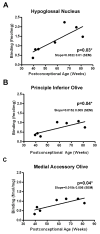5-HT2A receptors are concentrated in regions of the human infant medulla involved in respiratory and autonomic control
- PMID: 19213611
- PMCID: PMC2699562
- DOI: 10.1016/j.autneu.2009.01.004
5-HT2A receptors are concentrated in regions of the human infant medulla involved in respiratory and autonomic control
Abstract
The serotonergic (5-HT) system in the human medulla oblongata is well-recognized to play an important role in the regulation of respiratory and autonomic function. In this study, using both immunocytochemistry (n=5) and tissue section autoradiography with the radioligand (125)I-1-(2,5-dimethoxy-4-iodo-phenyl)2-aminopropane (n=7), we examine the normative development and distribution of the 5-HT(2A) receptor in the human medulla during the last part of gestation and first postnatal year when dramatic changes are known to occur in respiratory and autonomic control, in part mediated by the 5-HT(2A) receptor. High 5-HT(2A) receptor binding was observed in the dorsal motor nucleus of the vagus (preganglionic parasympathetic output) and hypoglossal nucleus (airway patency); intermediate binding was present in the nucleus of the solitary tract (visceral sensory input), gigantocellularis, intermediate reticular zone, and paragigantocellularis lateralis. Negligible binding was present in the raphé obscurus and arcuate nucleus. The pattern of 5-HT(2A) immunoreactivity paralleled that of binding density. By 15 gestational weeks, the relative distribution of the 5-HT(2A) receptor was similar to that in infancy. In all nuclei sampled, 5-HT(2A) receptor binding increased with age, with significant increases in the hypoglossal nucleus (p=0.027), principal inferior olive (p=0.044), and medial accessory olive (0.038). Thus, 5-HT(2A) receptors are concentrated in regions involved in autonomic and respiratory control in the human infant medulla, and their developmental profile changes over the first year of life in the hypoglossal nucleus critical to airway patency and the inferior olivary complex essential to cerebellar function.
Figures






Similar articles
-
The serotonergic anatomy of the developing human medulla oblongata: implications for pediatric disorders of homeostasis.J Chem Neuroanat. 2011 Jul;41(4):182-99. doi: 10.1016/j.jchemneu.2011.05.004. Epub 2011 May 27. J Chem Neuroanat. 2011. PMID: 21640183 Free PMC article. Review.
-
Retrograde labeling reveals extensive distribution of genioglossal motoneurons possessing 5-HT2A receptors throughout the hypoglossal nucleus of adult dogs.Brain Res. 2007 Feb 9;1132(1):110-9. doi: 10.1016/j.brainres.2006.10.099. Epub 2006 Dec 26. Brain Res. 2007. PMID: 17188659
-
Distribution of substance P-like immunoreactive fibres and terminals in the medulla oblongata of the human infant.Neuroscience. 1990;34(1):133-48. doi: 10.1016/0306-4522(90)90308-q. Neuroscience. 1990. PMID: 1691463
-
Catecholamines and serotonin in the caudal medulla of the rat: combined neurochemical-histofluorescence study.Brain Res Bull. 1982 Jul-Dec;9(1-6):227-36. doi: 10.1016/0361-9230(82)90135-6. Brain Res Bull. 1982. PMID: 7172028
-
Serotonin2 receptors in the nucleus tractus solitarius: characterization and role in the baroreceptor reflex arc.Cell Mol Neurobiol. 2003 Oct;23(4-5):709-26. doi: 10.1023/a:1025096718559. Cell Mol Neurobiol. 2003. PMID: 14514026 Free PMC article. Review.
Cited by
-
Diffusion tensor tractography of brainstem fibers and its application in pain.PLoS One. 2020 Feb 18;15(2):e0213952. doi: 10.1371/journal.pone.0213952. eCollection 2020. PLoS One. 2020. PMID: 32069284 Free PMC article.
-
Altered 5-HT2A/C receptor binding in the medulla oblongata in the sudden infant death syndrome (SIDS): Part I. Tissue-based evidence for serotonin receptor signaling abnormalities in cardiorespiratory- and arousal-related circuits.J Neuropathol Exp Neurol. 2023 May 25;82(6):467-482. doi: 10.1093/jnen/nlad030. J Neuropathol Exp Neurol. 2023. PMID: 37226597 Free PMC article.
-
Medullary serotonin defects and respiratory dysfunction in sudden infant death syndrome.Respir Physiol Neurobiol. 2009 Aug 31;168(1-2):133-43. doi: 10.1016/j.resp.2009.05.010. Epub 2009 May 27. Respir Physiol Neurobiol. 2009. PMID: 19481178 Free PMC article. Review.
-
Neuroanatomic relationships between the GABAergic and serotonergic systems in the developing human medulla.Auton Neurosci. 2010 Apr 19;154(1-2):30-41. doi: 10.1016/j.autneu.2009.10.002. Epub 2009 Nov 17. Auton Neurosci. 2010. PMID: 19926534 Free PMC article.
-
Raphe and ventrolateral medulla proteomics in sudden unexplained death in childhood with febrile seizure history.Acta Neuropathol. 2024 Nov 28;148(1):76. doi: 10.1007/s00401-024-02832-9. Acta Neuropathol. 2024. PMID: 39607506 Free PMC article.
References
-
- Azizi SA, Woodward DJ. Inferior olivary nuclear complex of the rat: morphology and comments on the principles of organization within the olivocerebellar system. J Comp Neurol. 1987;263(4):467–484. - PubMed
-
- Azmitia EC. Serotonin neurons, neuroplasticity, and homeostasis of neural tissue. Neuropsychopharmacology. 1999;21(2 Suppl):33S–45S. - PubMed
-
- Bach KB, Mitchell GS. Hypoxia-induced long-term facilitation of respiratory activity is serotonin dependent. Respir Physiol. 1996;104(2–3):251–260. - PubMed
-
- Baker-Herman TL, Fuller DD, Bavis RW, Zabka AG, Golder FJ, Doperalski NJ, Johnson RA, Watters JJ, Mitchell GS. BDNF is necessary and sufficient for spinal respiratory plasticity following intermittent hypoxia. Nat Neurosci. 2004;7(1):48–55. - PubMed
-
- Barnes NM, Sharp T. A review of central 5-HT receptors and their function. Neuropharmacology. 1999;38(8):1083–1152. - PubMed
Publication types
MeSH terms
Substances
Grants and funding
LinkOut - more resources
Full Text Sources

